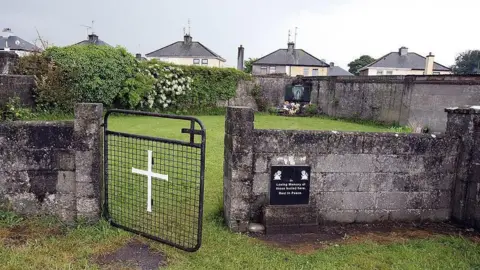**Pre-excavation Work Initiated at Historical Burial Site in Tuam**
In a significant development relating to Ireland’s troubling past, pre-excavation work has commenced at a mass burial site associated with a former mother-and-baby institution located in Tuam, County Galway. This action follows an investigation from 2016, where authorities unearthed “significant quantities of human remains” within underground chambers at the site, highlighting a dark chapter in Irish social history.
The institution under scrutiny was administrated by the Bon Secours Sisters, a religious order of Catholic nuns, and it primarily functioned from the 1920s until its closure in 1961. It served as a facility for unmarried mothers and their children during a period when societal stigma surrounding out-of-wedlock pregnancies was prevalent. Mothers, often ostracized by their families and communities, faced harsh living conditions and a lack of societal support during their time there.
Subsequent tests conducted on the remains discovered at the site confirmed that the bodies belonged mainly to infants and young children, with ages up to three years. The realization of such a significant number of undocumented deaths brought international attention to the injustices faced by women and children at the hands of these institutions.
The oversight of the excavation activities falls under the Office of the Director of Authorised Intervention (ODAIT), which operates independently and was formed under the Irish Institutional Burials Act of 2022. The aim of this office is to not only recover and analyze the human remains found at the site with respect but also to ensure a dignified burial process afterwards.
In the coming weeks, family members and survivors from the institution will get the opportunity to view the site’s perimeter where the excavations are taking place. Daniel MacSweeney from the ODAIT reported that the entire location, including any memorial areas, would be restricted to authorized personnel only, ensuring that the excavation maintains its forensic integrity and that operations adhere to international standards.
The initial phase of the project includes setting up the site infrastructure, marked by a 2.4-meter high hoarding installed around the burial ground to support security and the integrity of the findings during this sensitive excavation. 24-hour monitoring will also be in place to safeguard the site.
Describing the process as both “unique and incredibly complex,” MacSweeney emphasized that they expect the entire excavation activities to last approximately 24 months, although this estimate could change based on various factors that may arise as the work progresses.
The concerns regarding the burial site came to light via local historian Catherine Corless, who discovered that there are recorded death certificates for 796 children but disturbingly no burial records. This revelation led to the establishment of a government Commission of Investigation into Ireland’s mother-and-baby institutions, revealing that the structure where remains were found is actually located within a disused sewage tank, further compounding the distress surrounding the site.
As work begins in Tuam, it reflects a broader endeavor to illuminate the harrowing stories embedded in Ireland’s history regarding mother-and-baby homes. This excavation represents not just a search for answers regarding the past but also a memorialization of the lives lost within these institutions. The findings may continue to provoke discussions about accountability and reconciliation in Ireland, as the nation seeks to understand and process its historical wrongs regarding the treatment of women and children.
In summary, this significant excavation marks a pivotal step towards addressing the injustices of the past, providing an opportunity for remembrance and dignity for those who suffered in silence. The carefully conducted operations at Tuam may pave the way for better understanding and closure for the families affected, as Ireland confronts this painful chapter in its history.



